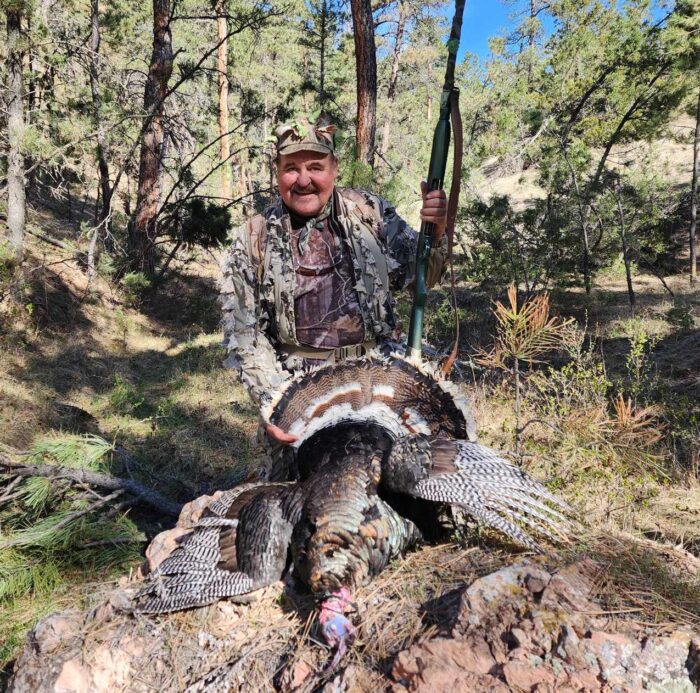 Turkeys are one of the hardest Big Game critters to hunt.
Turkeys are one of the hardest Big Game critters to hunt.
Now I know that some people have turkeys in their yards, pasture, and fields. They see them every day. If they wanted to shoot them with a rifle at long range they could. Some hunters stumble on to birds and get off some lucky shots. Other hunters ride around in wheelers and trucks and drive up on birds that they can quickly dispatch. Many landowners feed or illegally bait the turkeys. For most legal hunters, these methods are not “Textbook”, or the best sporting Turkey Techniques.
The Textbook Turkey hunt is hard to achieve. So many things can go wrong. The slightest movements, softest sounds, and poor stand selection are the first things to go wrong. Without using a mouth diaphragm call, you need to move hands or fingers to manipulate a call. This is important when you want to stop the bird for a shot.
If you are using decoys, you need to place them where you plan to shoot. The gobbler decoy should be facing you. The incoming gobbler will approach the male decoy face to face. The hen decoys can be looking away from your position. This puts you into the open where the bird can see you and takes time that you may not have. When you may see 50 yards in the forest, a turkey can see twice that. After all, you are in their living room. Decoys can also be targeted by inexperienced hunters. Ideally, place an orange ribbon over your stand site.
The Textbook Turkey hunt is not just about tagging a legal bird. Its about camo, calling, scouting, shooting, strategy, tactics, and ethical hunting. How you hunt and tag a Gobbler is what makes the hunt, and experience, more exciting and rewarding.
Turkeys are adapted for survival. They have superb eyesight, camo, hearing, and behaviors. If they could smell, you may never get a turkey in close enough to shoot. When turkeys are in a group, it becomes even harder to get close.
Proper calling is critical for a Textbook Turkey hunt. There are a variety of calls to use at certain times. Owl hooters will locate roosting birds. A crow or coyote call can encourage a shock, or surprise, gobble. A gobble call can do the same. Whines, purrs, clucks, and cackles all tell a story that can excite a wise old Gobbler.
The thick layers of feathers can stop shotgun BB’s from becoming mortal wounds. The only vulnerable area is the head. Hunters need to aim where the feathers stop, and the head begins. Several pellets need to hit this target for a clean and sporting kill. Anywhere else means messed up feathers/tails, broken wings, and a crippled bird requiring additional shots. Turkeys are too magnificent of birds to ruin and disrespect.
Now I am sure that there will be hunters that have little respect for turkeys. That’s probably because they have not tried to hunt turkeys using the Textbook style. Landowners also may not care for turkeys that frequent their homes and barns. To each their own.
This Spring, I scored on a Textbook Turkey hunt. After enjoying a sunrise with several gobblers sounding off around me and my son, everything went quiet around 8am. This meant that the gobblers were mating with hens and the hens were off laying eggs in their nests. The later gobbling happens when the hens leave, and the Gobbler is still in the mood.
As I have aged, my body has been a challenge. I am still recovering from 2 lower back surgeries, in 15 months. Endurance and sturdy walking are a challenge but getting better. Turkey hunting is part of my physical therapy. A ski pole made for a great walking stick.
Big Gobblers often set up a strut line. They puff up, gobble, and waddle/drag their wing tips back and forth. This is why gobbler wing feathers are worn off. When they hear a hen cluck or purr, they will hunt her down.
As I started to hunt back towards our camp, I heard a gobbler over 400 yards away. He was across the valley. When I made a few soft clucks, he triple gobbled back. I knew he was on his way. There was an opening ahead of me so I found a wide group of pines, in the shade, that would provide cover. I ditched my pack and prepared my calls. Next, I made sure the sighted in gun was loaded with 2 ¾ inch 12 gauge, 1 ¾ oz. #4 Turkey Loads.
In the middle of the clearing was a mound covered in short sagebrush. I expected the bird to show up at 20 yards. If I had moved to either side, I may have seen the bird sooner but then he could see me too. The gobbler had not made a sound for several minutes. I made a few soft purrs, and he gobbled back. The sound of a close in Gobbler vibrates up and down your spine. This is when a hunter gets the shakes. Nothing is more exciting than a gobbler in shotgun range, which is under 50 yards.
I could hear the gobbler puffing up his chest. They make a Vroom, vroom sound when doing this. Sometimes they also make soft putts and clucks. I couldn’t see him in full display, but that is what he was doing across the clearing. One more set of soft sexy purrs sealed the deal.
I raised my shotgun onto my knee for a comfortable rest. My diaphragm call was in my mouth and ready to purr so I could stop the bird. Suddenly the gobbler’s head popped up exactly where my gun was aimed. A moment later the head popped up a few feet to the right. It was like “whack amo”.
My safety clicked off, I adjusted my gun, and softly purred. He popped up and BOOM! The huge gobbler never knew what happened.
Turkey feathers shine in the sun. Their iridescent colors are beautiful. The beard is made from modified feathers. The spurs are used for protection and fighting. Big gobblers will have big spurs. They may have a shorter beard if the beard froze during the winter and broke off. When you hoist up a gobbler by his feet, the wings and tail open and the sight is rewarding and awesome.
After tagging the bird, you must do a quick gutting and place a rope around the legs and neck for a comfortable carry. Big Gobblers can weigh over 20 pounds. Now I needed to trek downhill and make my way over fallen logs and rocks through a narrow canyon back to camp. I took my time as I heard a stick break above me. It was my son Kyle checking on me. He was making sure that I was ok and had not fallen or become injured. I was sitting on a rock with a gobbler on my back as he showed up.
Not bad for a 70-year-old turkey hunter!
Montana Grant
